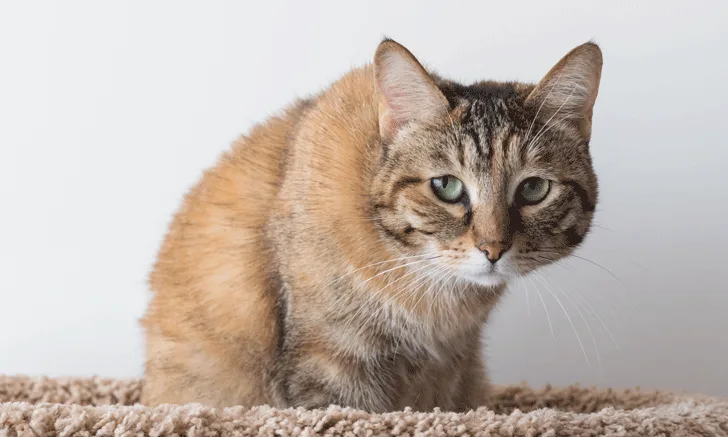Feline Osteoarthritis Pain: Tools for Clinicians & Pet Owners
Tamara Grubb, DVM, PhD, CVMA, CVPP, DACVAA, International Veterinary Academy of Pain Management Uniontown, Washington

Sponsored by Zoetis
KEY POINTS
Owners should be educated that cats experience pain from OA, which impacts health, QOL, and behavior. Behavioral and QOL scores and mobility animations such as those available through Zoetis can be useful tools on educating owners how to recognize OA-associated pain (see Education & Diagnostic Tools).
Using pain-specific questionnaires and performing feline-friendly, OA pain-specific examinations can help expedite a diagnosis of pain (see Education & Diagnostic Tools).
Solensia™ (frunevetmab injection) is a breakthrough treatment for the control of feline osteoarthritis (OA) pain.
Osteoarthritis (OA), a form of degenerative joint disease (DJD), is the most common cause of chronic pain in mammals, including cats. More than 90% of adult cats may have radiographic evidence of OA, with the presence/severity of disease expected to increase by >10% each year.1
Pain can be classified as either adaptive (physiologic) or maladaptive (pathologic). Adaptive pain facilitates tissue protection and healing, whereas maladaptive pain negatively impacts health, quality of life (QOL), and behavior, which can impact the human–animal bond, potentially leading to surrender or euthanasia of the pet.2 OA is a nonhealing disease, with OA-associated pain having no protective benefit; thus, OA causes maladaptive pain that, without treatment, progressively worsens as peripheral and central sensitization and neuropathic pain develop.1
Although OA is not curable, if identified and treated early, the progression of the intensity of OA pain can be slowed, providing a prolonged period of controllable pain and good QOL (likely a normal lifespan). Because OA is more common in geriatric cats,1,3 OA screening should begin when cats reach 7 to 10 years of age.
Recognizing OA-Associated Pain
OA-associated pain may not be obvious—to owners and to veterinary teams.4 Because cats are evolutionarily both predators and prey, their natural instinct is to hide any vulnerability that could increase predation, including pain. Tools such as checklists, animations, and videos can help owners and veterinary teams accurately recognize and assess pain associated with OA in cats.
Tools for Owners
Although the expected prevalence of OA is similar between dogs and cats, cat owners may be less likely than dog owners to identify pain in their pet.4 However, educating owners on the prevalence of OA-associated pain and available treatment options may make owners more likely to bring their cat to the clinic.5
Owner education starts with an understanding of feline behavior and mobility. Owners should understand that the clinical signs of OA-associated pain are rarely what is expected but the impact of pain (ie, pain-mediated changes in behavior, activity, and mobility) can still be identified. Behavior and activity changes related to urination/defecation, grooming, and social interactions (with humans and/or other pets) are often indicators of pain and, if not due to pain, could be due to other conditions that may require medical attention. Cats are largely sedentary, making pain-related mobility changes challenging to observe. Cats are also often semi-nocturnal, so owners may be sleeping when cats exhibit mobility changes. Feline OA is often idiopathic and bilateral as compared with canine OA, which is primarily secondary and unilateral.6-8 Thus, classic limping as exhibited by dogs is unlikely to be exhibited by cats. In addition, cats also spend more time moving vertically (eg, jumping, climbing) as compared with dogs. Vertical mobility changes, which most owners do not know how to identify, are important indicators of OA-associated pain.
Checklists can be useful in a variety of settings, including medical diagnostics. Using checklists with specific painrelated behavior/activity questions can educate the owner on the potential presence of pain and expedite diagnosis by alerting the clinician to pain-related concerns (see Education & Diagnostic Tools). Questions on a checklist should focus on the cat’s behavior and activity. Mobility discussions should center on the cat’s ability to jump and climb.
Videos and animations may help owners understand mobility in patients with OA, as the owner may more readily identify with observing the cat in motion. Detailed animations are available and can be effective diagnostic tools, comparing the movement of a cat with healthy, nonpainful joints with a cat with painful osteoarthritic joints as the cats climb up and down stairs, jump up and down, and jump to/from elevated surfaces, among others (see Education & Diagnostic Tools). Providing mobility animations on the clinic website and/or social media can also be beneficial; they can also be displayed on TV or computer screens in the lobby or examination rooms.
Infographics describing changes in behavior-related pain are also available (see Education & Diagnostic Tools). Clinicians should strive to be a preeminent resource for animal health information. Thus, infographics and questionnaires should be shared on the clinic website and/or social media and hard-copies made available in the clinic. Information regarding this material can also be included by audio in the clinic’s on-hold phone recording.
Tools for Clinicians
In a study of 90 geriatric cats with radiographic changes of DJD, only 4 had DJD or arthritis mentioned in their medical records.3 Although radiographic changes do not consistently predict the presence of pain, there is some correlation, 9 and it could therefore be assumed that >4 of these 90 cats were painful.
Identifying feline pain can be difficult for the clinician if not specifically investigated. Clinicians rarely observe a cat walking at the clinic as commonly occurs with dogs; thus, gait analysis is not typically a normal part of a non-pain–related examination. Having the owner explore checklists and mobility animations prior to the visit can increase the likelihood of pain being identified, as the owner’s input will provide a template for pointed pain-related, cat-specific questions.
A feline-friendly musculoskeletal examination focused on joint-specific pain and mobility using gentle palpation and range of motion should be a part of any examination for patients in which pain is a potential problem and for every examination for cats >7 to 10 years of age. Detailed videos on feline-friendly, pain-focused musculoskeletal examinations in cats are available (see Education & Diagnostic Tools) and include thorough evaluative descriptions of the patient and several joints, including the hip, stifle, tarsus, and elbow—common locations for feline OA. Asking the owner to video their cat at home can also help facilitate diagnosis, as mobility and behavior can be more accurately assessed when the cat is in an environment it is familiar with. Radiography can provide valuable information and is recommended; however, some patients will have radiographic lesions with no pain, and some patients may have pain that is worse than the radiographic evidence.7,10 Regardless, pain should be the focus of treatment, not the radiographic changes.
Education & Diagnostic Tools
Feline Examination Videos: felineOAexam.com
Feline OA Education Tools for Owners: SolensiaVetTeam.com
Feline OA Owner Checklist: catOAchecklist.com
The International Veterinary Academy of Pain Management: ivapm.org
Role of Nerve Growth Factor in OA Pain: thenewscienceofOApain.com
Zoetis Technical Bulletin: Current & Future State of Disease: felineOApain.com
The New Science of OA Pain Management
Nerve growth factor (NGF) is a cytokine that has recently been recognized as a major factor in the generation, propagation, and sensation of pain.11-13 Once released from damaged tissue, including tissue in an osteoarthritic joint, NGF rapidly escalates pain due to its impact on multiple pain pathway components, resulting in maladaptive pain.11-13 NGF binds to tropomyosin receptor kinase A (trkA) and causes nociceptor sensitization, which can lead to hyperalgesia and/or allodynia; this is augmented by the release of other inflammatory mediators (eg, histamine, bradykinin) and additional NGF following NGF binding to trkA on proinflammatory cells (eg, mast cells). In addition, the NGF/trkA complex is internalized and transported to the neuronal cell body in the dorsal root ganglion, where it promotes the expression and/or upregulation of a variety of other pronociceptive ion channels and receptors, including transient receptor potential vanilloid 1, which is integral for development of central sensitization.11-13 Because of profound pronociceptive involvement and NGF’s ability to rapidly produce both peripheral and central sensitization, NGF is an obvious target for the control of OA pain. Anti-NGF monoclonal antibodies bind to specific target molecules, including cytokines, and block the activity of the target. Specified (felinized and caninized) anti-NGF monoclonal antibodies are FDA-approved and can provide a first-line option for safe and effective management of OA pain.14,15
Treatment of Feline OA
Analgesia is foundational to a multimodal OA treatment approach because it is multidimensional and offers a unique individual experience for feline patients. NSAIDs are an effective treatment option but are not approved in the United States for chronic use in cats and can cause adverse effects, including renal dysfunction, which is a common concern in cats.16 Solensia™ (frunevetmab injection), a once-monthly monoclonal antibody injection for safe and effective control of feline OA pain, targets NGF, a key driver in OA pain progression, and is eliminated via normal protein degradation pathways like naturally produced antibodies, with minimal involvement of the liver or kidneys.14,17 In a 3-month study, 77% of cat owners reported improvement in signs of pain when their cats were treated monthly with Solensia.* Nonpharmacologic treatment (eg, acupuncture, laser and physical therapy) should be considered for multimodal therapy. Although nutraceuticals and specific joint diets may be effective and could be added to the protocol as multimodal therapy, they have demonstrated little to no efficacy in cats. Most of these compounds are likely more effective at slowing disease progression, which may potentially delay the onset of worsening pain, than they are at providing analgesia directly. By targeting 1 of the key mediators in the feline OA pain pathway, Solensia helps keep OA pain from disrupting the unique bond cats share with their humans.
Conclusion
OA can cause maladaptive, potentially excruciating, pain in cats. Although owners may struggle to identify pain in their cat, educating owners on the prevalence of OA-associated pain and available treatment options may make owners more likely to bring their cat to the clinic. Education can be provided through numerous resources, such as posters, questionnaires, and mobility animations. Providing education to owners through these means can also help expedite a diagnosis of OA, as pointed questions regarding changes in behavior and mobility can help more quickly identify pain. Incorporating these tools can help both the owner and the clinician more readily identify feline OA-associated pain, thus improving patient quality of life and helping cats get back to their normal.
*67% of cat owners reported improvement in signs of their cat’s pain in the placebo group.
IMPORTANT SAFETY INFORMATION
For use in cats only. Women who are pregnant, trying to conceive or breastfeeding should take extreme care to avoid self-injection. Hypersensitivity reactions, including anaphylaxis, could potentially occur with self-injection. SOLENSIA should not be used in breeding cats or in pregnant or lactating queens. SOLENSIA should not be administered to cats with known hypersensitivity to frunevetmab. The most common adverse events reported in a clinical study were vomiting and injection site pain. See full Prescribing Information on next page or visit SolensiaPI.com.
